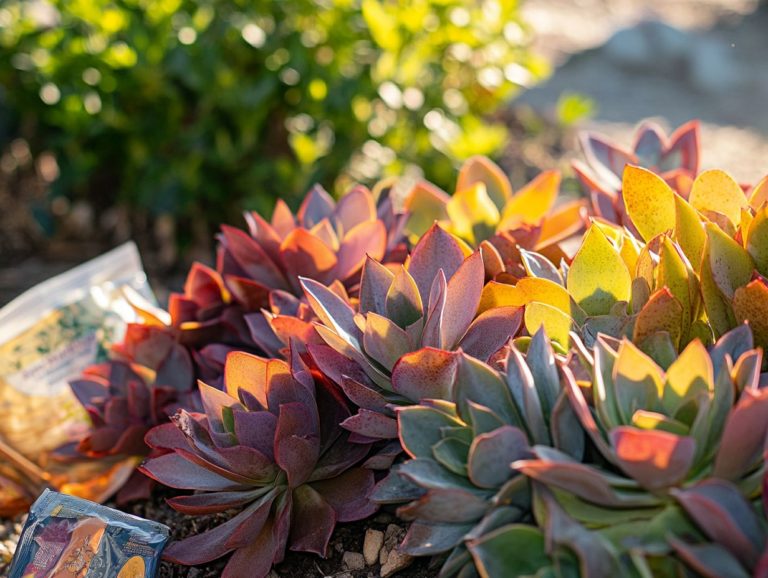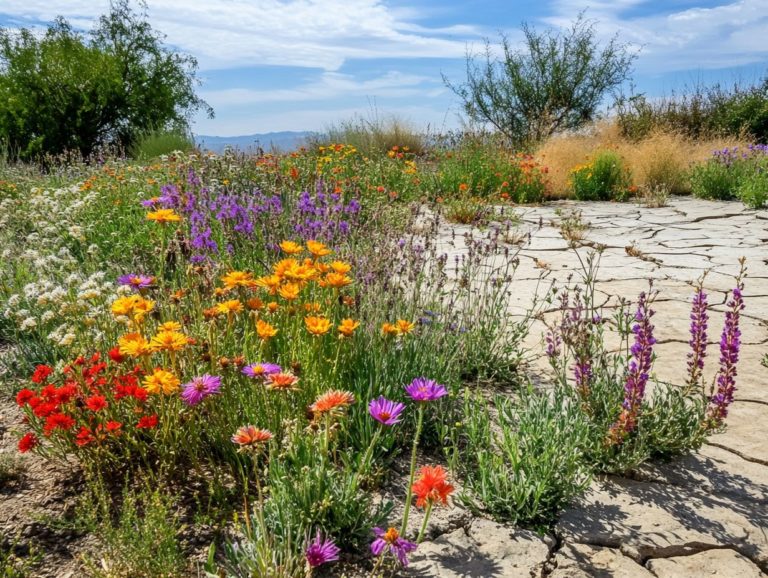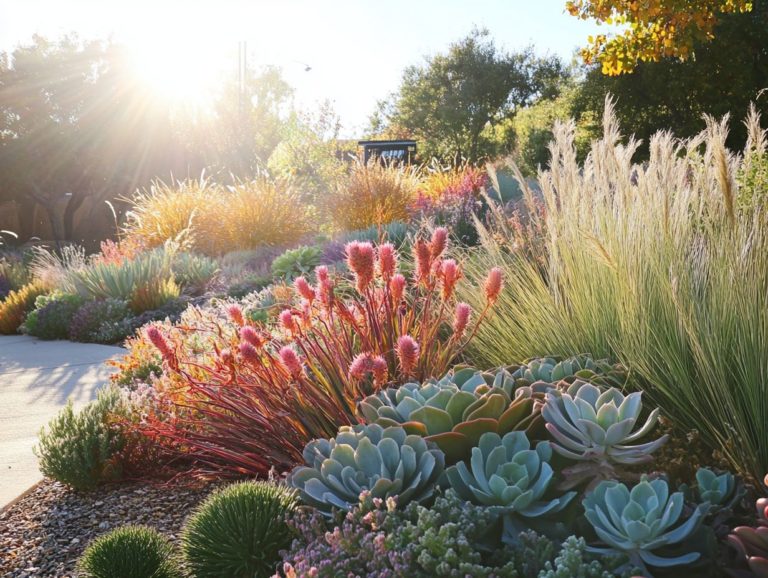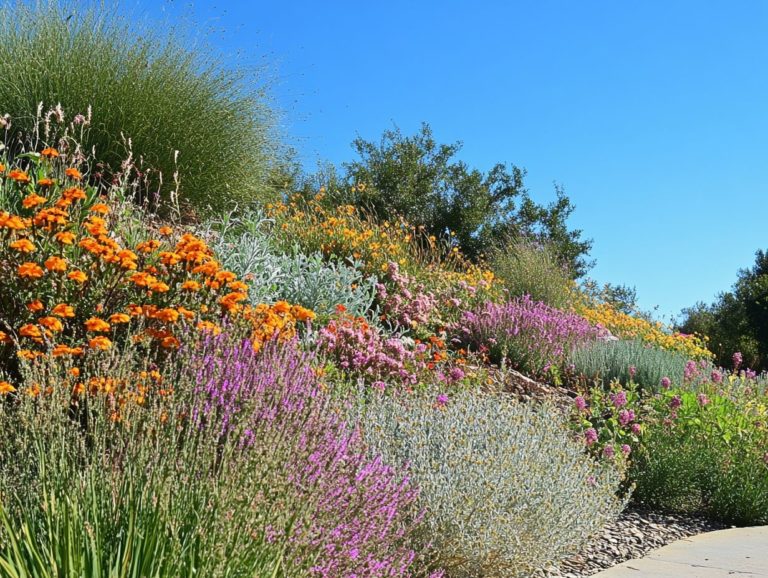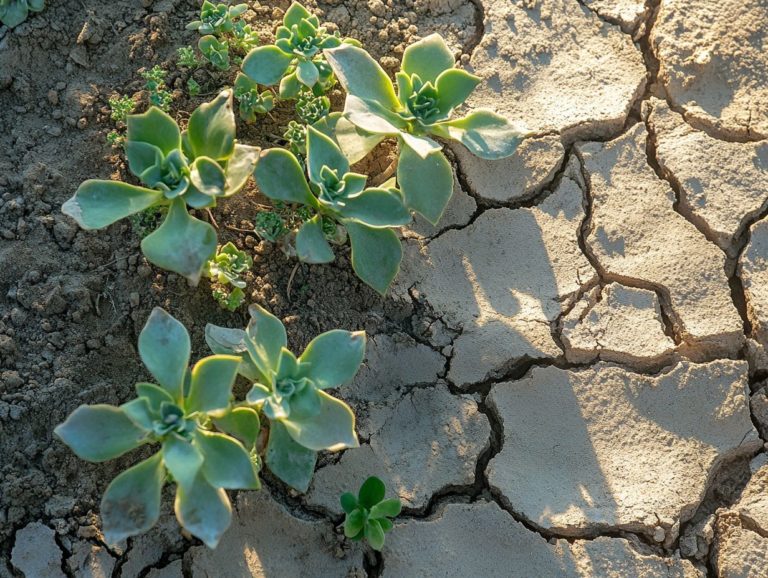How to Choose Drought-Resistant Plants?
Drought-resistant plants are becoming increasingly essential as climate change reshapes landscapes and affects water availability.
Understanding what makes these plants resilient will empower you to cultivate a flourishing garden that conserves precious resources.
This guide delves into the advantages of selecting drought-resistant varieties, highlighting key factors to consider, such as climate and soil types, as well as various plants to choose from.
You ll discover invaluable tips for maintaining these hardy options, ensuring your garden thrives even during dry spells.
Whether you re a seasoned gardener or just starting out, this guide will equip you with the knowledge you need to make informed choices for a sustainable garden.
Contents
- Key Takeaways:
- Understanding Drought-Resistant Plants
- Benefits of Choosing Drought-Resistant Plants
- Factors to Consider When Choosing Drought-Resistant Plants
- Types of Drought-Resistant Plants
- Tips for Maintaining Drought-Resistant Plants
- Frequently Asked Questions
- What does it mean for a plant to be drought-resistant?
- How can I tell if a plant is drought-resistant?
- Can I still have a beautiful garden with drought-resistant plants?
- Are there any other benefits to choosing drought-resistant plants?
- What are some tips for choosing the right drought-resistant plants for my garden?
- Can I still grow fruits and vegetables with drought-resistant plants?
Key Takeaways:
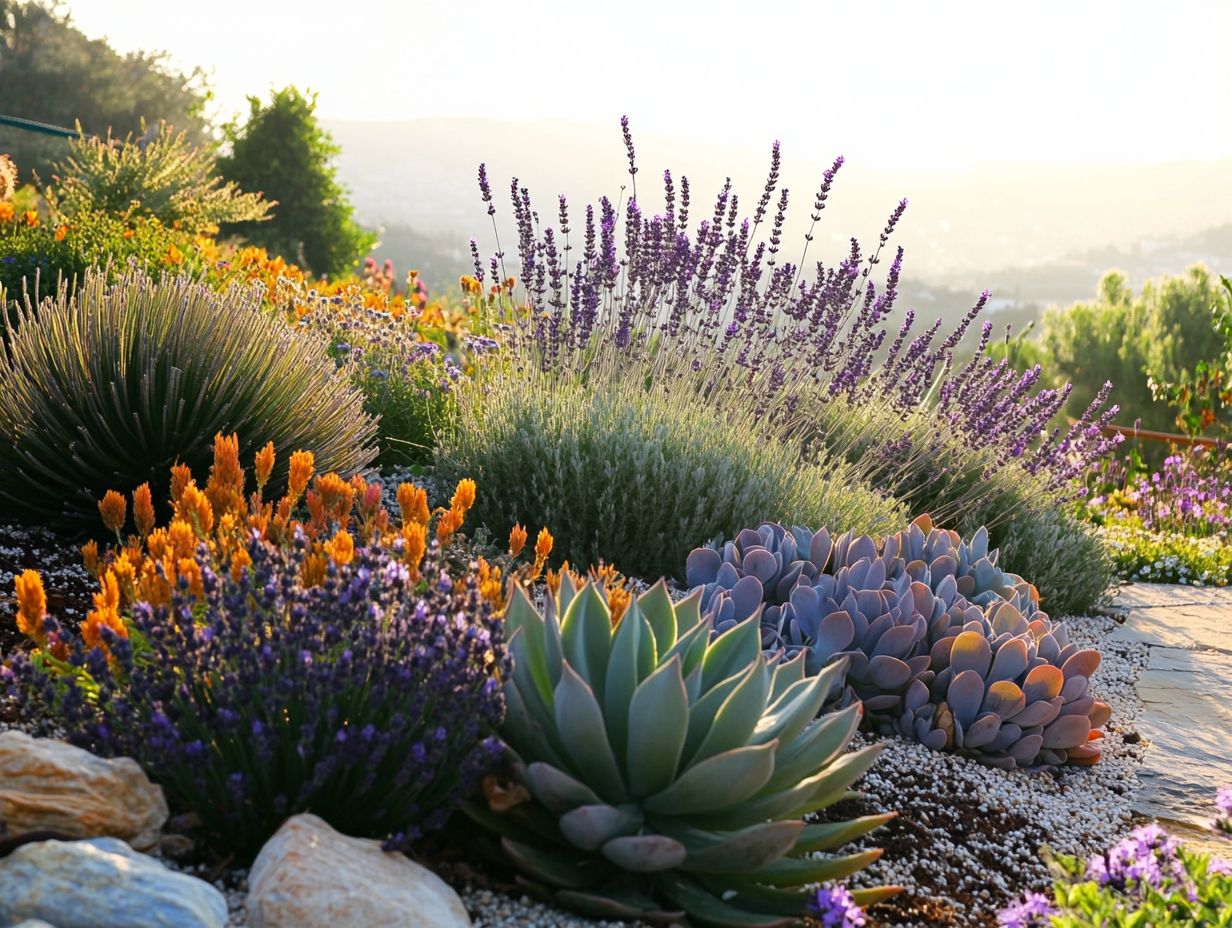
- Choose drought-resistant plants that are well-adapted to your local climate and soil conditions to ensure their survival and minimize maintenance needs.
- By opting for these plants, you can save water, reduce your water bills, and contribute to a more sustainable environment.
- Proper maintenance, including watering and pruning, is crucial for their health and longevity. Regular care helps these plants thrive in dry conditions.
Understanding Drought-Resistant Plants
Understanding drought-resistant plants is essential, especially as climate change and unpredictable weather patterns become more prevalent. Learning how to design a drought-resistant landscape can help you utilize these remarkable plants that thrive in low water availability and play a crucial role in resource conservation and sustainable landscaping practices.
Add drought-resistant plants to your garden and watch it flourish! They enhance the landscape appeal of your outdoor spaces while contributing to food security and ecological balance.
Familiarizing yourself with their unique characteristics enables you to create vibrant, beautiful landscapes, even in high-heat conditions where traditional plants may falter.
What Makes a Plant Drought-Resistant?
Plants labeled as drought-resistant possess unique features that enable them to flourish in low-water environments. These adaptations often include a specialized root system that efficiently absorbs water, alongside features that enhance moisture retention and improve soil drainage.
The depth of the root system is particularly essential; deeper roots can access moisture that shallower-rooted plants cannot, ensuring better water uptake during dry spells.
Many of these resilient species have leaf structures designed to minimize evaporation, often featuring waxy coatings or reduced leaf surface areas that effectively conserve water.
Some possess extraordinary water storage capabilities within their tissues, allowing them to stockpile moisture and utilize it efficiently during harsh conditions. Understanding these physical features is crucial for developing effective drought management strategies, especially in arid landscapes where organic matter is essential for maintaining soil health.
Benefits of Choosing Drought-Resistant Plants
Opting for drought-resistant plants presents numerous environmental and financial advantages, making them an astute choice for contemporary landscaping.
By significantly cutting down on water usage, these plants play a crucial role in water conservation efforts, particularly in areas grappling with drought and climate change impacts. Their reduced maintenance needs lower your gardening costs.
Their resilience ensures that your landscape remains visually appealing, even in the peak of summer, allowing your garden to not just survive but truly thrive.
Start your drought-resistant garden today and make a difference!
Environmental and Cost Benefits
The environmental and cost benefits of adopting drought-resistant plants in your landscaping are significant and multifaceted. These plants not only conserve water but also enhance biodiversity and soil health, contributing to a more sustainable ecosystem.
From a financial standpoint, they minimize the need for extensive irrigation and maintenance, ultimately leading to lower gardening costs. By choosing varieties tailored to your local climate, you could see your water usage drop by as much as 50%, according to recent studies.
This not only translates into substantial savings on your utility bills but also plays a part in protecting local water resources. Drought-resistant landscaping encourages a wider array of flora and fauna, nurturing healthier ecosystems that can thrive even amid changing climates.
For instance, native species typically require fewer inputs, resulting in reduced use of chemicals for pest control and improved soil structure. This approach fosters healthier gardens and aligns with broader conservation efforts aimed at sustaining biodiversity for generations to come.
Factors to Consider When Choosing Drought-Resistant Plants
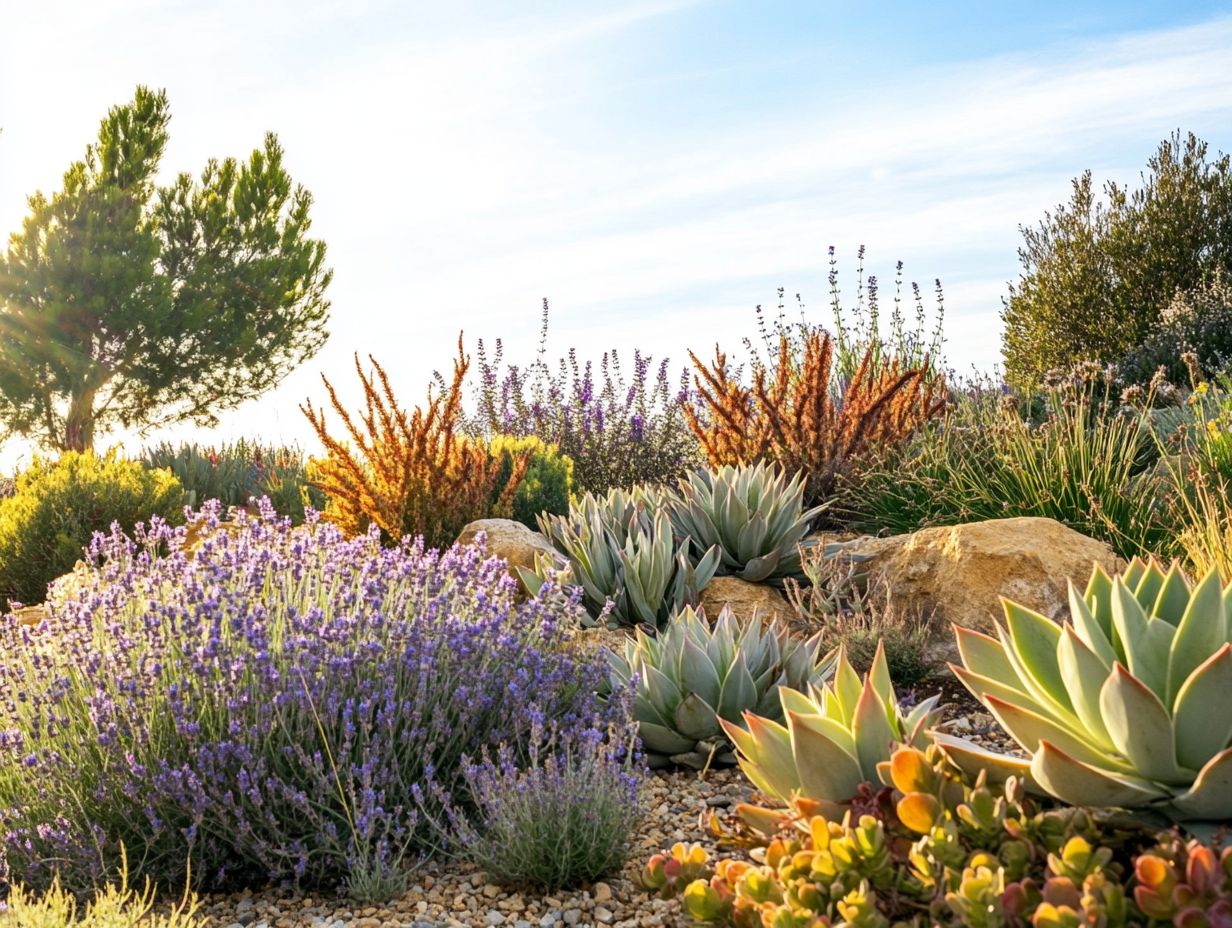
When you’re choosing drought-resistant plants for your garden, it’s vital to consider several key factors that will influence their success. Learning how to choose plants for drought resistance involves thinking about climate, soil conditions, and specific water needs, as well as the unique traits that help plants survive with little water of each variety.
Each plant has its own unique requirements. Understanding these details can greatly enhance their growth and the overall functionality of your landscape.
By carefully evaluating your local climate conditions and soil types, you can make informed choices on how to incorporate drought-resistant plants that will lead to a flourishing drought-tolerant garden.
Climate and Soil Conditions
It’s crucial to understand the climate and soil conditions in your area when selecting drought-resistant plants, as these elements directly influence plant performance and resilience. Learning why to choose drought-resistant plants will help you make informed decisions. The type of soil you have, be it sandy or clay, will impact root development and moisture retention.
Sandy soils drain quickly, leading to lower moisture availability. Therefore, it’s vital to opt for plants with deeper root systems that can tap into remaining moisture. In contrast, clay soils excel at retaining water but can become compacted, restricting root growth.
Understanding the pH and nutrient levels in your soil helps you choose plants that are drought-resistant and well-suited to the existing ecosystem. This ensures healthier growth and promotes better sustainability over time.
Water Needs and Maintenance
Each drought-resistant plant presents its own unique water needs and maintenance requirements, so it’s crucial to grasp the intricacies of caring for these resilient species. While many drought-tolerant plants flourish with minimal watering, their specific requirements can vary significantly.
You should prioritize thorough research on each plant to determine the optimal watering schedule and soil conditions that foster growth without risking over-saturation. Keeping an eye on factors such as the plant’s age and the sunlight it receives will greatly enhance your success.
Implementing mulch helps retain moisture and regulate soil temperature while keeping weeds at bay. Adopting efficient irrigation techniques, like drip systems, will further optimize your water usage.
By meticulously assessing these elements, you can cultivate a thriving, low-maintenance landscape that stays vibrant even under challenging conditions. Start planning your drought-tolerant garden today for a vibrant, sustainable landscape!
Types of Drought-Resistant Plants
Explore an exciting variety of drought-resistant plants that can transform your garden! Whether you choose native or non-native options, the possibilities are endless.
You have a wealth of drought-resistant plants at your fingertips, each presenting unique benefits and aesthetic appeal. From native varieties that flourish in your local environment to non-native species that effortlessly adapt to drought conditions, you’ll find an impressive selection of the best drought-resistant plants.
Moreover, succulents, cacti, and various drought-resistant trees and shrubs offer an extensive range of options tailored to complement different landscaping styles and meet your specific needs.
Native Plants vs. Non-Native Plants
The decision between choosing native and non-native drought-resistant plants can profoundly affect the success of your landscaping endeavors. Native plants are well-suited to your local climate and require less water, while non-native plants may need more care to thrive.
Choosing native plants supports local ecosystems. They provide essential homes and food for local wildlife, enhancing biodiversity. However, non-native drought-resistant plants can bring unique aesthetic appeal, introducing a range of colors and textures that local species may lack. Yet, they often require careful management to prevent them from outcompeting native plants, which can disturb the local ecology.
By assessing these characteristics, you can make informed choices that align with your landscaping goals while fostering sustainability and harmony within your environment.
Succulents and Cacti
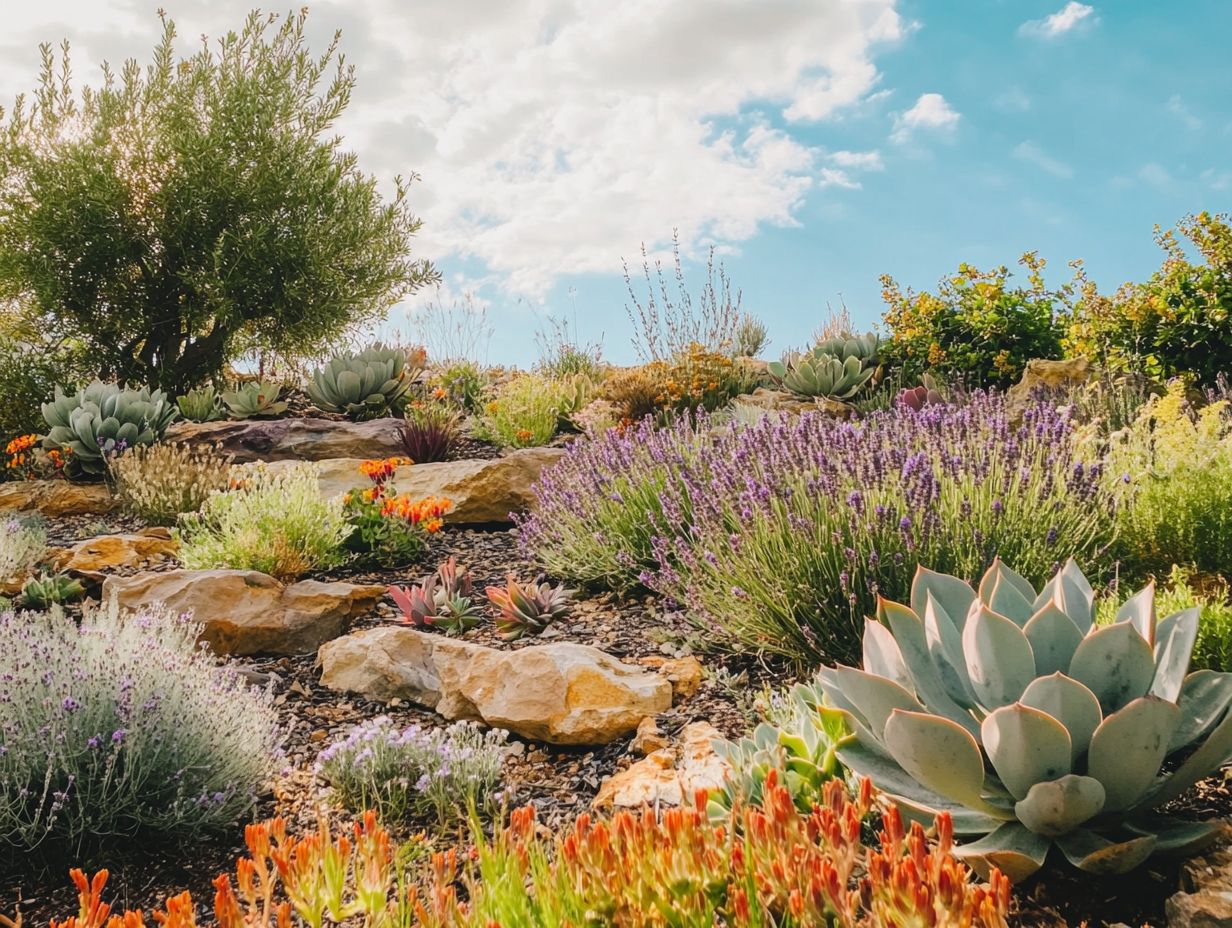
Succulents and cacti stand out as premier choices among drought-resistant plants, and learning how to prepare soil for drought-resistant plants can further enhance their growth. They are celebrated for their exceptional ability to retain moisture.
Their fascinating adaptations, such as thick, fleshy leaves, enable them to store water with remarkable efficiency, making them perfect for gardens in arid climates or areas with limited irrigation.
These resilient plants come in a stunning variety of shapes, sizes, and colors, adding a dynamic visual element that elevates the aesthetic of any landscape. They demand minimal care and flourish in well-drained soil, often requiring just a few gallons of water each season making them incredibly easy to maintain.
Their adaptability allows you to place them in various settings, from rock gardens to urban patios, providing a touch of beauty while contributing to water conservation efforts. By incorporating succulents and cacti into your gardening designs, you not only create a captivating visual display but also promote sustainable practices, making them the ideal choice for the eco-conscious gardener.
Drought-Resistant Trees and Shrubs
Drought-resistant trees and shrubs do more than just beautify your landscape; they create homes for animals and improve soil health. These resilient plants endure harsh weather while providing essential shade and shelter.
When you choose these species, you can cultivate a vibrant garden that requires less water and maintenance, paving the way for sustainable landscaping practices. These hardy plants are critical in fostering biodiversity; their roots stabilize the soil and reduce erosion, while their foliage serves as shelter and food for a variety of wildlife.
This unique combination of aesthetic appeal and ecological benefits enriches your gardening experience and positively impacts local ecosystems. Opting for drought-resistant trees and shrubs is a savvy choice for any landscaper aiming to blend beauty with functionality.
Tips for Maintaining Drought-Resistant Plants
To maintain drought-resistant plants effectively, you ll need to employ specific strategies that allow them to flourish even in challenging conditions. Proper watering and fertilization are vital components for ensuring the health and longevity of these plants.
Understanding their unique requirements in relation to soil types and climate is essential. By incorporating regular plant care practices, you can truly maximize the potential of your drought-tolerant garden, creating a resilient and thriving landscape.
Start planting drought-resistant plants today! Embrace the beauty and sustainability they bring to your garden.
Proper Watering and Fertilization
Proper watering and fertilization are essential for the success of your drought-resistant plants. These methods ensure your plants receive the nutrients and moisture they need to thrive. Techniques may vary based on soil types and specific plant requirements. Mastering the balance between water intake and nutrient delivery is crucial.
Using drip irrigation enhances water efficiency. This method directs moisture right to the plant roots while reducing evaporation loss. Adding organic matter, like compost or well-rotted manure, improves soil health and its ability to retain moisture, creating a sustainable environment for your resilient plants.
A mulching strategy can help reduce water evaporation and regulate soil temperature. This provides extra support during dry spells. By monitoring soil moisture and adjusting your fertilization schedules, you can create an ideal growth platform for drought-tolerant species.
Pruning and Pest Control
Regular pruning and effective pest control are vital for maintaining healthy drought-resistant plants. Pruning encourages robust growth and flowering, while managing pests and diseases that threaten these resilient species.
Removing dead or overcrowded branches enhances air circulation and sunlight exposure, both crucial for photosynthesis the process plants use to convert light into energy. Aim to prune in late winter or early spring, just before new growth begins.
Consider natural pest control methods, such as introducing beneficial insects like ladybugs or using neem oil. These approaches can significantly reduce harmful pest populations without relying on harsh chemicals. Such strategies protect plant health and promote a thriving ecosystem.
Frequently Asked Questions
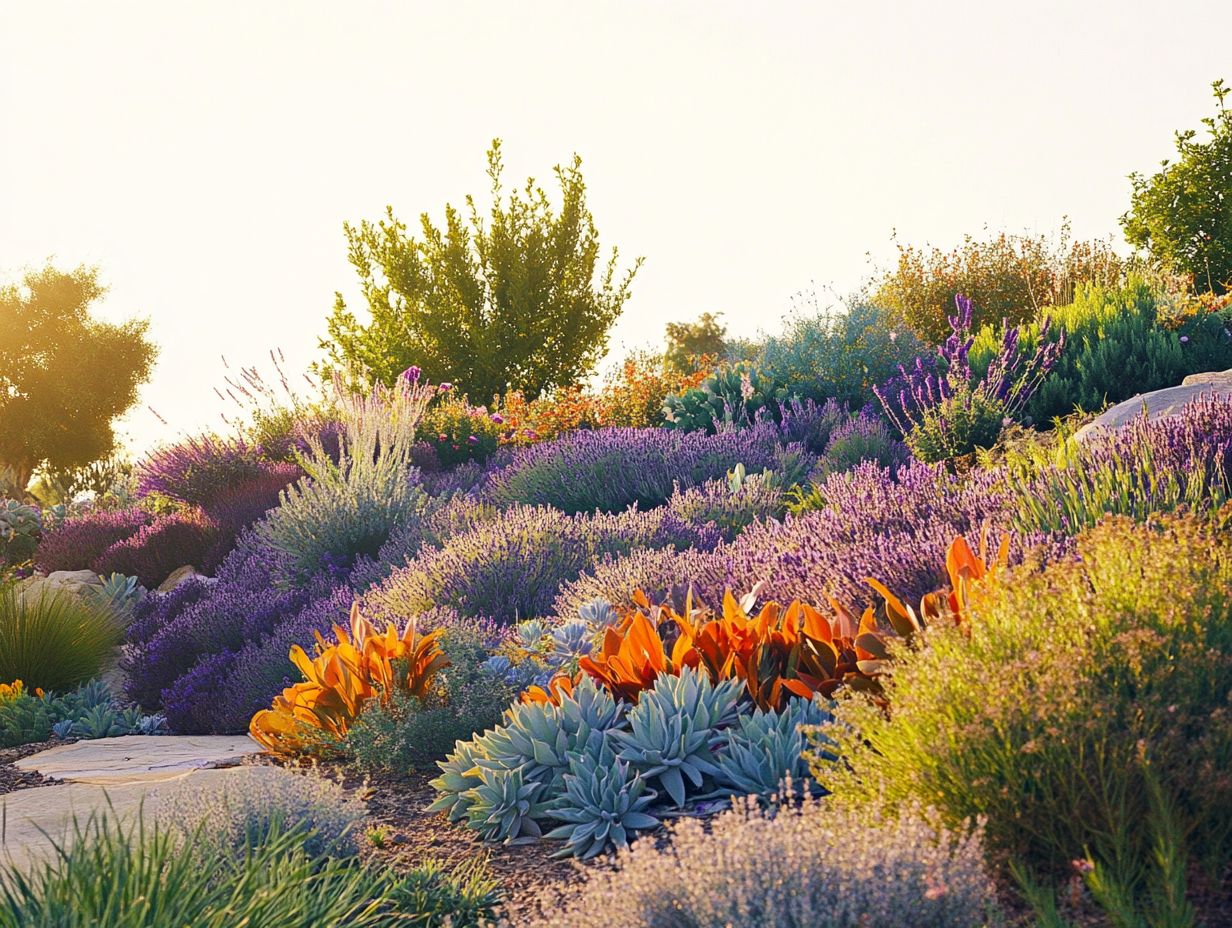
What does it mean for a plant to be drought-resistant?
Drought-resistant plants survive in hot, dry conditions with minimal water. To optimize your garden, it’s important to learn how to plan a drought-resistant garden layout, as they efficiently store water and have survival mechanisms to withstand drought.
How can I tell if a plant is drought-resistant?
Look for plants with thick, waxy leaves or small, needle-like leaves, as these are often signs of drought resistance. Additionally, learning how to identify drought-resistant plants can help you choose options with deep root systems that can access water in dry soil more effectively.
Can I still have a beautiful garden with drought-resistant plants?
Absolutely! Many drought-resistant plants boast vibrant flowers and foliage, making them beautiful additions to any garden. Popular choices include lavender, succulents, and ornamental grasses.
Are there any other benefits to choosing drought-resistant plants?
Yes! Drought-resistant plants require less maintenance and watering, saving you time and money. They help conserve water and are more environmentally friendly.
What are some tips for choosing the right drought-resistant plants for my garden?
Consider your area’s climate and soil conditions, along with the sunlight and water your garden receives. To make informed choices, refer to resources on how to identify drought-resistant plants quickly and choose native plants that are proven to survive in drought conditions.
Can I still grow fruits and vegetables with drought-resistant plants?
Yes, many drought-resistant options exist for growing fruits and vegetables. Popular choices include tomatoes, peppers, and herbs. Be sure to water them regularly, especially during peak growing times.
Start your own drought-resistant garden today and enjoy the beauty of resilient plants!

